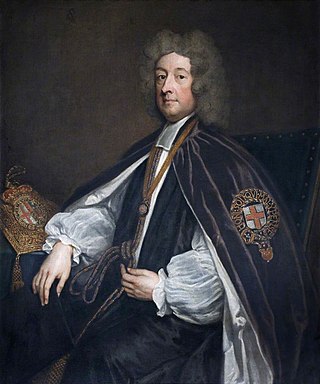Related Research Articles

John Nichols was an English printer, author and antiquary. He is remembered as an influential editor of the Gentleman's Magazine for nearly 40 years; author of a monumental county history of Leicestershire; author of two compendia of biographical material relating to his literary contemporaries; and as one of the agents behind the first complete publication of Domesday Book in 1783.

William Talbot was an English Anglican bishop. He was Bishop of Oxford from 1699 to 1715, Bishop of Salisbury from 1715 to 1722 and Bishop of Durham from 1722 to 1730.
George Henry Dashwood was a British antiquary.
John Allen (1789–1829) was an English bookseller and antiquary, notable for his work on the history of Herefordshire.
The Lord President of Connaught was a military leader with wide-ranging powers, reaching into the civil sphere, in the English government of Connaught in Ireland, in the sixteenth and seventeenth centuries. The office was created in 1569, and in 1604 was reconstituted with full powers to hear all civil suits, to impose martial law and to proceed with "fire and sword" against the King's enemies. The width of his powers gave rise to clashes with the longer established courts: in 1622 he and the Lord President of Munster were ordered not to "intermeddle' in cases which were properly within the remit of those courts. He was assisted by a council whose members included the Chief Justice of Connacht, one or two associate justices and the Attorney General for the Province of Connacht. The office was abolished in 1672.
Thomas Madox was a legal antiquary and historian, known for his publication and discussion of medieval records and charters; and in particular for his History of the Exchequer, tracing the administration and records of that branch of the state from the Norman Conquest to the time of Edward II. It became a standard work for the study of English medieval history. He held the office of historiographer royal from 1708 until his death.
Abraham Hartwell, the younger (1553/4–1606), was an English translator and antiquary, and Member of Parliament. Another Abraham Hartwell of the period was also an author, publishing Regina Literata in 1564, and the two have in the past been confused.

The Chief Baron of the Irish Exchequer was the Baron (judge) who presided over the Irish Court of Exchequer. This was a mirror of the equivalent court in England, and was one of the four courts which sat in the building in Dublin which is still called The Four Courts.
Richard Astry was an English antiquary.
Thomas D'Oyly was an English antiquary.

Hudson Gurney was an English antiquary and verse-writer, also known as a politician. He was a member of the Gurney family.
Francis Tate (1560–1616) was an English antiquary and politician, Member of Parliament for Northampton and Shrewsbury.
English county histories, in other words historical and topographical works concerned with individual ancient counties of England, were produced by antiquarians from the late 16th century onwards. The content was variable: most focused on recording the ownership of estates and the descent of lordships of manors, thus the genealogies of county families, heraldry and other antiquarian material. In the introduction to one typical early work of this style, The Antiquities of Warwickshire published in 1656, the author William Dugdale writes:
I offer unto you my noble countriemen, as the most proper persons to whom it can be presented wherein you will see very much of your worthy ancestors, to whose memory I have erected it as a monumentall pillar and to shew in what honour they lived in those flourishing ages past. In this kind, or not much different, have divers persons in forrein parts very learnedly written; some whereof I have noted in my preface: and I could wish that there were more that would adventure in the like manner for the rest of the counties of this nation, considering how acceptable those are, which others have already performed
Joseph John Skelton (1783–1871) was an English engraver.
John Barthlet or Bartlett, was an English theological writer.

William Becket (1684–1738) was an English surgeon and antiquary.
John Bruce (1802–1869) was an English antiquary, closely associated with the Camden Society.
This article is about the particular significance of the year 1726 to Wales and its people.
This article is about the particular significance of the year 1710 to Wales and its people.
This article is about the particular significance of the year 1708 to Wales and its people.
References
- . Dictionary of National Biography . London: Smith, Elder & Co. 1885–1900.
- Attribution
![]() This article incorporates text from a publication now in the public domain : "Talbot, Thomas (fl.1580)". Dictionary of National Biography . London: Smith, Elder & Co. 1885–1900.
This article incorporates text from a publication now in the public domain : "Talbot, Thomas (fl.1580)". Dictionary of National Biography . London: Smith, Elder & Co. 1885–1900.